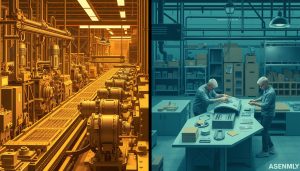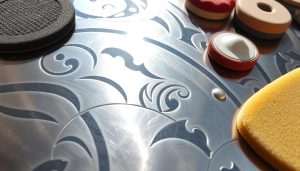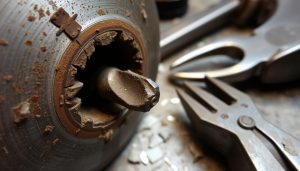In the world of manufacturing, die casting has emerged as a versatile and highly efficient metal forming process. From automotive components to household appliances, die casting plays a crucial role in shaping the products we use every day. As manufacturers navigate the landscape of die casting, they often face a critical decision: should they opt for low pressure or high pressure die casting? This choice can have a profound impact on the quality, cost-effectiveness, and overall success of a project.
Understanding the nuances between low pressure and high pressure die casting is essential for making an informed decision. This article delves into the fundamentals of each process, highlighting their respective advantages, ideal applications, and material considerations. By exploring these key differences, manufacturers can determine the most suitable approach for their unique project requirements, ultimately ensuring the production of high-quality, cost-effective products.
What is Die Casting?
Die casting is a metal molding technique that involves forcing molten metal into a mold cavity under high pressure. This process produces intricate, precision-engineered parts with a consistent, high-quality finish. Die casting is a versatile manufacturing method used across a wide range of industries, from automotive and aerospace to consumer electronics and medical devices.
Overview of the Die Casting Process
The die casting process typically involves the following steps:
- Molten metal is poured into a die (a hollow metal form)
- The die is clamped shut and the metal is forced into the die cavity under high pressure
- The metal quickly solidifies, taking the shape of the die cavity
- The die is opened, and the solidified part is ejected
- The die is prepared for the next casting cycle
How Low Pressure and High Pressure Die Casting Differ
While both low pressure and high pressure die casting involve forcing molten metal into a die, the two processes differ in several key ways:
| Characteristic | Low Pressure Die Casting | High Pressure Die Casting |
|---|---|---|
| Pressure | Relatively low pressure (typically less than 100 psi) | Extremely high pressure (up to 30,000 psi) |
| Part Complexity | Suitable for simpler, thicker-walled parts | Capable of producing highly complex, thin-walled parts |
| Production Speed | Slower cycle times compared to high pressure die casting | Faster production rates due to the high-pressure injection |
| Metals Used | Primarily aluminum and magnesium alloys | Wider range of metals, including aluminum, zinc, and copper alloys |
The choice between low pressure and high pressure die casting depends on the specific requirements of the project, such as part complexity, production volume, and material selection.
Low Pressure Die Casting
In the world of casting processes, low pressure die casting (LPDC) stands out as a highly efficient and versatile technique. This innovative method offers a multitude of advantages that make it an attractive choice for a wide range of applications. Let’s explore the benefits of low pressure die casting and delve into the ideal scenarios where it truly shines.
Advantages of Low Pressure Die Casting
One of the primary advantages of low pressure casting benefits is the exceptional level of control it provides over the casting process. By precisely regulating the pressure, LPDC ensures a consistent and uniform distribution of the molten metal, resulting in high-quality parts with exceptional dimensional accuracy and reduced defects. This precision translates to enhanced product performance and a longer lifespan for the finished components.
Ideal Applications for Low Pressure Die Casting
The LPDC applications span a diverse array of industries, making it a widely sought-after casting method. From the automotive sector, where LPDC is used to produce intricate engine components, to the aerospace industry, where it is utilized for the fabrication of lightweight and durable structural parts, the versatility of this process is truly remarkable.
Material Selection and Process Considerations
When it comes to low pressure die materials, LPDC offers a wide range of options, including aluminum, magnesium, and even copper-based alloys. The selection of the appropriate material is crucial, as it directly impacts the final product’s properties, such as strength, corrosion resistance, and thermal conductivity. By carefully considering the material requirements and the specific process parameters, manufacturers can optimize the LPDC process to achieve the desired outcomes.

“The precision and control offered by low pressure die casting make it a highly sought-after technology in industries where quality and performance are paramount.”
As the benefits of low pressure die casting continue to be recognized, this innovative technique is poised to play an increasingly significant role in shaping the future of modern manufacturing. By understanding the unique advantages and applications of LPDC, designers and engineers can harness its power to create exceptional products that meet the ever-evolving demands of the market.
High Pressure Die Casting
As a highly efficient and versatile manufacturing process, high pressure die casting (HPDC) offers numerous advantages that make it a preferred choice for a wide range of industrial applications. By understanding the benefits of HPDC and the materials commonly used in this process, manufacturers can make informed decisions to optimize their production and meet their specific needs.
Benefits of High Pressure Die Casting
High pressure die casting boasts several key advantages that contribute to its widespread use in the manufacturing industry:
- Rapid production speed, enabling the creation of complex parts with high dimensional accuracy and repeatability
- Excellent surface finish quality, often eliminating the need for extensive secondary operations
- Improved mechanical properties, such as increased strength and durability, thanks to the high-pressure injection process
- Cost-effective manufacturing due to the automated nature of the HPDC process and the ability to produce large volumes of parts
When to Choose High Pressure Die Casting
High pressure die casting is particularly well-suited for the production of intricate and complex parts that require a high degree of precision and consistency. Industries such as automotive, electronics, and consumer goods often rely on HPDC to manufacture components that demand these attributes. The speed and efficiency of the HPDC process make it an ideal choice for high-volume production runs, where streamlined manufacturing is essential.
Common Materials Used in High Pressure Die Casting
HPDC accommodates a wide range of materials, each with its own unique properties and applications. Some of the most commonly used materials in high pressure die casting include:
| Material | Properties | Common Applications |
|---|---|---|
| Aluminum Alloys | Lightweight, corrosion-resistant, good thermal and electrical conductivity | Automotive parts, electronics housings, appliance components |
| Zinc Alloys | High dimensional accuracy, excellent surface finish, cost-effective | Automotive hardware, consumer electronics, hardware fittings |
| Magnesium Alloys | Extremely lightweight, high strength-to-weight ratio, good corrosion resistance | Automotive components, electronics enclosures, aerospace parts |
By carefully selecting the right material for the application, manufacturers can optimize the performance, cost-effectiveness, and overall efficiency of their high pressure die casting projects.
Comparison of Low Pressure and High Pressure Die Casting
When it comes to selecting the right die casting process for your manufacturing needs, understanding the key differences between low pressure die casting (LPDC) and high pressure die casting (HPDC) is crucial. This section delves into a comprehensive comparison, highlighting the distinct advantages and considerations of each method.
Cost and Production Efficiency
Low pressure die casting is generally a more cost-effective solution, particularly for smaller production runs. The tooling and equipment required for LPDC are typically less expensive than those needed for HPDC. Additionally, LPDC can offer higher material efficiency, as the casting process generates less waste. However, HPDC boasts superior production efficiency, allowing for higher volume output and faster cycle times, making it more suitable for large-scale manufacturing.
Surface Finish Quality
High pressure die casting is renowned for its ability to produce parts with exceptional surface finish quality. The high-pressure injection of molten metal into the die cavity results in a smooth, consistent surface finish, often eliminating the need for additional post-processing steps. In contrast, low pressure die casting can yield a slightly rougher surface finish, which may require additional finishing operations.
Production Speed and Volume
| Metric | LPDC | HPDC |
|---|---|---|
| Cycle Time | Longer | Shorter |
| Production Rate | Lower | Higher |
| Scalability | Limited | Greater |
The high-speed injection process of HPDC allows for faster cycle times and higher production rates compared to LPDC. This makes HPDC better suited for high-volume manufacturing operations. Additionally, the scalability of HPDC is more extensive, enabling the production of a wider range of part sizes and complexities.

In summary, the choice between LPDC and HPDC ultimately depends on the specific requirements of your project, including factors such as production volume, part complexity, and desired surface finish. By understanding the distinct advantages and limitations of each process, you can make an informed decision that aligns with your manufacturing goals and delivers the best results.
Choosing the Right Die Casting Process for Your Project
Selecting the appropriate die casting process, whether low pressure or high pressure, is crucial for the success of your manufacturing project. Several key factors, such as production volume, part complexity, and material requirements, should be carefully evaluated to make an informed decision.
Factors to Consider: Volume, Complexity, and Material Requirements
When determining the right die casting process, it’s important to assess your project’s production needs. Low pressure die casting is well-suited for lower-volume runs and complex parts, while high pressure die casting excels in high-volume production of simpler geometries. Additionally, the choice of material, be it aluminum, zinc, or magnesium, can also influence the optimal die casting method for your project.
How to Make an Informed Decision for Your Project
To make an informed decision, it’s advisable to consult with experienced die casting experts who can guide you through the process selection, taking into account your specific requirements. They can provide valuable insights on the advantages and limitations of each method, helping you determine the most cost-effective and efficient solution for your manufacturing needs.
Shixinproto’s Die Casting Services for Your Manufacturing Needs
At Shixinproto, we offer comprehensive die casting services to meet the diverse requirements of our clients. Our team of die casting experts can help you navigate the selection process, ensuring you choose the right die casting method for your project. Whether you require low pressure or high pressure die casting, we have the capabilities and expertise to deliver high-quality, cost-effective solutions that meet your manufacturing goals.
FAQ
What is the difference between low pressure and high pressure die casting?
What are the advantages of low pressure die casting?
- Better control over metal flow
- Reduced turbulence
- Improved part quality with fewer defects
- Capability to use a wider range of materials
- Superior surface finishes
When is high pressure die casting the better choice?
- Faster cycle times
- Higher throughput
- The ability to produce complex, thin-walled parts with intricate designs
- Excellent dimensional accuracy
How do the costs and production efficiencies compare between the two methods?
- Low Pressure Die Casting: Higher upfront tooling cost but more cost-effective for lower-volume production runs due to its controlled process.
- High Pressure Die Casting: Lower tooling cost and better suited for high-volume, mass-production scenarios, with faster cycle times and greater output offsetting the initial investment.
What factors should I consider when choosing between low pressure and high pressure die casting?
- Production volume
- Part complexity
- Material requirements
- Desired surface finish
- Cost-effectiveness and lead times
- Specific performance or functional needs for the final product





